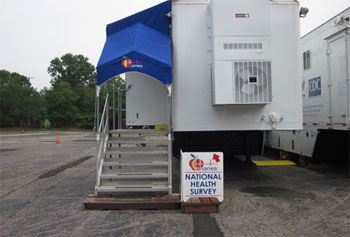By Robin Latham

The four trailers in two neat rows temporarily resting in a hotel parking lot in suburban Maryland don’t look like much, but they may be the most valuable part of a decades-long initiative to chart the health and well-being of the American public. Put together, the four 52-foot trailers make up a moveable state-of-the-art medical facility gathering data for the National Health and Nutrition Examination Survey (NHANES). Administered by the Centers for Disease Control and Prevention (CDC), NHANES is the only nationally representative health survey in the United States that combines in-person interviews with physical examinations. Now, for the first time in the six decades it has been in operation, NHANES, thanks to support from the NIDCD, is gathering information about taste and smell function in adult Americans.
Thanks to NHANES’ careful collection of health and health behavior data, and its analyses by epidemiologists and biomedical researchers, scientists have been able to substantiate the dangers of second-hand cigarette smoke, for example, and the health consequences of exposure to lead-based paint. If you have children, you’re well acquainted with NHANES, whose data built the growth charts your pediatrician uses to determine how well your baby is developing compared to other babies of the same age.
Although NHANES has included a hearing test for decades, the NIDCD has been trying to add assessments for taste and smell function since 1997, when it first began working with the National Center for Health Statistics (NCHS) to develop reliable tests.
“Taste and smell, our chemosensory perceptions, form the basis for what we choose to eat or drink,” says Howard Hoffman, M.A., program director of epidemiology and statistics at the NIDCD, and one of the prime movers of the initiative to include taste and smell tests in the NHANES battery. “Does the ability to taste and smell impact nutrition? I would say so, but in what ways and to what degree remains uncertain.”
NHANES has been in operation since the 1960s as an initiative of NCHS. In 1987, NCHS became one of the components of the CDC, and in 1999, NHANES became a continuously operating survey, administered in two-year cycles.
In 2004, the NIDCD made a strategic decision to tag a taste test onto the ongoing Beaver Dam Offspring Study (BOSS), which was conducted among a group of more than 5,000 residents of Beaver Dam, Wisconsin. The test used filter paper impregnated with salty, sweet, sour, and bitter substances to test taste sensitivity.
“The NCHS wanted proof that any tests we proposed using would be feasible in a large-scale epidemiological study,” says Mr. Hoffman. “Once they saw that the Beaver Dam study was able to implement reliable tests of both taste and smell function, they were sold.”
The NIDCD continued work on a smell test that used scratch and sniff cards of common food smells, such as garlic, chocolate, and strawberry, and unpleasant or warning odors, such as gasoline, smoke, and natural gas. The taste test was refined to use bitter and salty oral solutions applied to the tip of the tongue and in the whole mouth, a process graphically described as “rinse, sip, and spit.”
In January 2012, the tests were added to NHANES on a pilot basis, and in January 2013 the tests were adopted into the NHANES survey. The NIDCD continues to support the effort with funding for monitoring and assuring the quality and reliability of the exams and questionnaire in the field. Data collection will continue through December 2014, at which point it’s expected that more than 4,000 adult Americans, 40 years and older, will have been evaluated. Questions about problems with the ability to smell and taste have also been added to the at-home questionnaire so that researchers will have a full complement of exam-based and self-reported data to work from when the full data set is released in 2015.
The half-day NHANES exam includes the usual types of tests you’d find in a standard physical exam, such as those that measure height, weight, blood pressure, and cholesterol levels, but it also includes a thorough nutritional assessment using sample size bowls, plates, and cups to help people more accurately describe what, and how much, they eat. In a separate home visit, an NHANES worker uses a carefully crafted questionnaire to document day-to-day activities, lifestyle behaviors, symptoms of illness, and chronic health conditions. Corresponding census data provides demographic and socioeconomic information.
One of the driving forces behind this push for the inclusion of taste and smell measures in NHANES was the sheer lack of knowledge available about taste and smell dysfunction in the adult American population. Local community-based studies estimated that up to 15 percent of adults might have a smell or taste problem, but a representative nationwide exam-based survey had never been conducted.
By adding tests that measure taste and smell function to the nutritional information NHANES already collects, epidemiologists and biomedical researchers will be able to take a closer look at the role of taste and smell in nutrition and health. Just as important, thanks to the physical exams and detailed medical histories NHANES technicians collect, researchers will be able to explore associations between taste and smell dysfunction and medical conditions such as high blood pressure and diabetes, as well as brain disorders such as Parkinson’s and Alzheimer’s diseases, which are characterized by an early loss of smell.
“The potential for this is enormous,” says Susan Sullivan, Ph.D., the NIDCD’s program director for smell and taste research. “We haven’t had a national survey like this before, so we have no idea what novel and unanticipated findings may come out of this. With objective data to look at as far as prevalence goes, we can start to test hypotheses about risk factors for, and the consequences of, impairment in the ability to taste or smell.”

